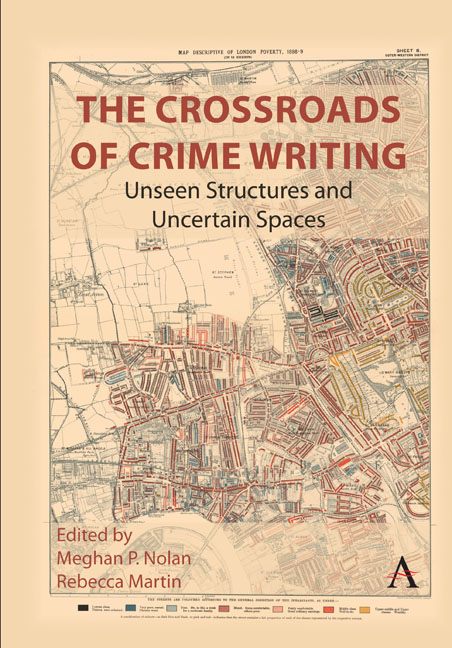Book contents
- Frontmatter
- Contents
- Introduction
- Unseen Structures
- Chapter 1 Unseen Structures and the Outlaw: Depictions of Violations in Stieg Larsson’s Millennium Trilogy
- Chapter 2 Dark Waters: Eco-Noir in New York 2140
- Chapter 3 Between Lenin and Sherlock Holmes: Soviet Militsiya Procedural in Volodymyr Kashin’s Detective Fiction
- Chapter 4 Detecting Justice: Black Crime Fiction and the Novels of Attica Locke
- Chapter 5 The Police and the Private Eye: The Making of Gendered and Racial Peripheralization in the Crime Fiction of Valerie Wilson Wesley
- Uncertain Spaces
- Chapter 6 Navigating the Carceral City: Calcutta in Late Nineteenth-Century Narratives of Detection
- Chapter 7 Traversing the Borders of Poverty and Morality: The Intersection of Maps and Upper-Class Ethics in Anne Perry’s Neo-Victorian Series
- Chapter 8 Facts and Fictions: The Liminal Space Between True Crime and Crime Fiction
- Chapter 9 The Success(Ion) and Corruption of Crime Genres in Jo Nesbø’s Macbeth (2018)
- Chapter 10 The Golden Age Meets the Age of Aquarius: Agatha Christie in the 1960s
- Notes on Editors and Contributors
- Permissions
- Index
Introduction
Published online by Cambridge University Press: 13 April 2024
- Frontmatter
- Contents
- Introduction
- Unseen Structures
- Chapter 1 Unseen Structures and the Outlaw: Depictions of Violations in Stieg Larsson’s Millennium Trilogy
- Chapter 2 Dark Waters: Eco-Noir in New York 2140
- Chapter 3 Between Lenin and Sherlock Holmes: Soviet Militsiya Procedural in Volodymyr Kashin’s Detective Fiction
- Chapter 4 Detecting Justice: Black Crime Fiction and the Novels of Attica Locke
- Chapter 5 The Police and the Private Eye: The Making of Gendered and Racial Peripheralization in the Crime Fiction of Valerie Wilson Wesley
- Uncertain Spaces
- Chapter 6 Navigating the Carceral City: Calcutta in Late Nineteenth-Century Narratives of Detection
- Chapter 7 Traversing the Borders of Poverty and Morality: The Intersection of Maps and Upper-Class Ethics in Anne Perry’s Neo-Victorian Series
- Chapter 8 Facts and Fictions: The Liminal Space Between True Crime and Crime Fiction
- Chapter 9 The Success(Ion) and Corruption of Crime Genres in Jo Nesbø’s Macbeth (2018)
- Chapter 10 The Golden Age Meets the Age of Aquarius: Agatha Christie in the 1960s
- Notes on Editors and Contributors
- Permissions
- Index
Summary
Over a century ago, in his examination of “The Sensational in Modern English Prose Fiction” (1919), Walter Clarke Phillips declared, “Whatever sources of appeal may come or go, there is one which from the very structure of modern democratic society seldom bids for applause unheeded—that is, the appeal to fear” (2). It is to this appeal that we owe the abundance of crime writing at our disposal—a trove of mystery that undoubtedly fascinates in its ability to entertain while safely reflecting the ugliest truths about ourselves and the societies in which we live. In this vein, crime fiction persists as one of the most popular genres of literature across the globe, a fact that is further evinced by the inundation of onscreen adaptations of crime narratives, dramas, capers, and comic books which now, more than ever, reflect our common anxieties about the perceived failures of modern social institutions. That is because, as Catherine Nickerson asserts in “Murder as Social Criticism,” crime fiction “is deeply enmeshed with most of the thornier problems of the Victorian, modern, and postmodern eras, including gender roles and privileges, racial prejudice and the formation of racial consciousness, the significance and morality of wealth and capital, and the conflicting demands of privacy and social control” (1997, 744). Thus, crime fiction would appear to be the perfect vehicle for examining the origins and endurance of those societal fears which are firmly grounded in such conceptions and the perceived boundaries that perpetuate them, but this volume argues that we must examine those boundaries in fiction and nonfiction crime writing with an awareness of and turn toward the unseen structures that produce the spatial uncertainties that so often lead to such collective anxieties.
This collection makes a unique contribution to current scholarship on crime writing by gathering in one place texts that take multifaceted approaches to how these boundaries are drawn and how they respond to changes—sudden and forced or unseen and gradual—in relation to social and/or political power.
- Type
- Chapter
- Information
- The Crossroads of Crime WritingUnseen Structures and Uncertain Spaces, pp. 1 - 18Publisher: Anthem PressPrint publication year: 2024

